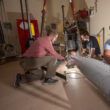Balancing modernization and disarmament
By Lu Yin |
In nuclear arms control and disarmament, one sees two competing trends at play: an aspiration in many quarters to eliminate nuclear weapons and a practical desire among nuclear weapon states to modernize their arsenals. What sort of balance between these forces can be achieved?
Nuclear powers feel the need to modernize their arsenals for three main reasons. First, in today's international security environment, they still see nuclear weapons as necessary, mainly for deterrence purposes. Second, nuclear weapons continue to play a very important role in maintaining global strategic stability. Third, as long as nuclear arsenals exist, modernization is necessary in order to keep weapons safe and reliable.
Advocates for disarmament, meanwhile, argue that nuclear weapons must be prohibited and arsenals destroyed because of the disastrous consequences that would befall the human race if these weapons were ever used. Nuclear weapon states themselves, even as they emphasize the necessity of modernizing their arsenals, acknowledge that nuclear weapons ought to be eliminated eventually. For example, the Obama administration in 2009 launched a vigorous initiative toward achieving a world free of nuclear weapons.
But today's heavy US investment in nuclear modernization seems at odds with the objective of nuclear disarmament. Between 2014 and 2023, the United States is expected to spend $355 billion on modernization. Reductions in US warheads envisioned under the New Strategic Arms Reduction Treaty (New Start) will be offset by upgrades in the quality of the US arsenal. Meanwhile, Washington's Prompt Global Strike and ballistic missile defense programs have posed new challenges to strategic stability.
China also feels the need to modernize its nuclear forces—in order to enhance survivability and maintain a credible minimum nuclear deterrent. But these are China's only objectives for its nuclear weapons. Among the five recognized nuclear weapon states, China is the only nation that has committed to an unconditional no-first-use policy. This policy has consistently placed restraints on China's nuclear force development (which, in any case, has never been a top priority in Beijing's military modernization drive). China consistently advocates for a world free of nuclear weapons. It has never participated in a nuclear arms race. It has never deployed nuclear weapons in any other country's territory.
Unfortunately, most nuclear-armed states—including the United States—still assign nuclear weapons a very important role in their strategies for safeguarding security. Washington, in its most recent Nuclear Posture Review, decided to no longer assign certain marginal or unrealistic tasks to nuclear weapons, but made no fundamental changes to the role of US nuclear weapons or to nuclear war-fighting strategy. As long as nuclear weapons play such a crucial role in US strategy, and as long as the United States maintains its desire for absolute security, Washington will not reduce its nuclear arsenal to relatively low levels or make dramatic changes to its current modernization program. Much the same holds true for Russia.
So, nuclear-armed nations see modernization as indispensable, but further disarmament progress seems impossible as long as modernization programs continue apace. What's the way out of this bind? The key—because national nuclear strategies determine the direction of nuclear programs—is to adjust national strategies so that less emphasis is given to the role of nuclear weapons.
If the United States and Russia significantly alter their nuclear strategies, further substantial reductions in arsenals are possible. If the two nations' arsenals are reduced, other states will be encouraged to consider how and when they might participate in multilateral disarmament processes. Multilateral disarmament will be no easy task—as shown by the history of US-Russia disarmament negotiations, even bilateral processes are very difficult. Still, further progress by the United States and Russia could serve as an inspiration to other nuclear-armed nations.
But there's a further complication—missile defense systems and Prompt Global Strike capacities pose a serious threat to strategic stability and to disarmament. New Start imposed no restrictions on the development of ballistic missile defense or advanced conventional weapons, and developments in either technology could trigger a renewed nuclear arms race. Consequently, great discretion is required regarding the development and deployment of such systems. (New Start, incidentally, also leaves the United States with a strong nuclear "upload" capability. That is, the United States retains ample space on deployed missiles to redeploy warheads that have been taken out of service. Russia, in contrast, has little upload capacity.)
Eliminating nuclear weapons does not appear feasible at this stage. Modernizations of nuclear arsenals are certain to go forward. But it's possible—and very important—to achieve a balance between modernization and disarmament. Under such an approach, nuclear strategy would be adjusted so that nuclear weapons assumed less importance in national security. The practical reasons for possessing nuclear weapons would gradually disappear. All nuclear-armed countries would be encouraged to reduce their arsenals. But it's the United States and Russia, the two nuclear superpowers, that must take the lead, establish trust, and set a good example for other nations.















